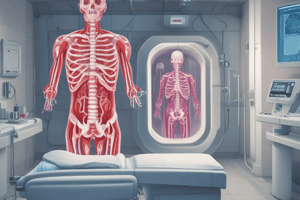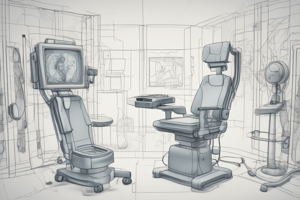Podcast
Questions and Answers
What type of tissues can be evaluated using X-rays?
What type of tissues can be evaluated using X-rays?
- Blood vessels
- Hard tissues (correct)
- Soft tissues
- Internal organs
Who oversees all the care on a particular unit?
Who oversees all the care on a particular unit?
- Nurse Manager (correct)
- Nurse Practitioner
- Clinical Nurse Specialist
- Staff Educator
What is the role of a Staff Educator?
What is the role of a Staff Educator?
- To educate staff about the latest information (correct)
- To prescribe medications
- To provide medical care to patients
- To manage a hospital unit
What type of degree do Clinical Nurse Specialists typically hold?
What type of degree do Clinical Nurse Specialists typically hold?
What is a Nurse Practitioner?
What is a Nurse Practitioner?
Who provides diagnostic, therapeutic, and preventive healthcare services under the supervision of physicians?
Who provides diagnostic, therapeutic, and preventive healthcare services under the supervision of physicians?
What is a Hospitalist?
What is a Hospitalist?
What is an Intern/Resident?
What is an Intern/Resident?
What type of radiation do X-rays use?
What type of radiation do X-rays use?
When were X-rays first used on humans?
When were X-rays first used on humans?
What type of images do X-rays produce?
What type of images do X-rays produce?
What is the purpose of X-ray therapy?
What is the purpose of X-ray therapy?
What is the purpose of ultrasound therapy?
What is the purpose of ultrasound therapy?
What type of images do ultrasounds produce?
What type of images do ultrasounds produce?
What is the difference between X-rays and ultrasounds?
What is the difference between X-rays and ultrasounds?
When were ultrasounds first used on humans?
When were ultrasounds first used on humans?
What is referred to as mental health disorders?
What is referred to as mental health disorders?
What can be affected by symptoms of mental illness?
What can be affected by symptoms of mental illness?
What is an example of a symptom of mental illness?
What is an example of a symptom of mental illness?
What is thought to be a cause of mental illnesses?
What is thought to be a cause of mental illnesses?
What may increase the risk of developing a mental illness?
What may increase the risk of developing a mental illness?
What can sometime be linked to mental illness?
What can sometime be linked to mental illness?
What type of brain chemicals are involved in mental illness?
What type of brain chemicals are involved in mental illness?
What can mental illness symptoms sometimes appear as?
What can mental illness symptoms sometimes appear as?
What is the primary function of the nervous system?
What is the primary function of the nervous system?
Which of the following is a division of the peripheral nervous system?
Which of the following is a division of the peripheral nervous system?
What is the role of the parasympathetic nervous system?
What is the role of the parasympathetic nervous system?
What is the main function of the enteric nervous system?
What is the main function of the enteric nervous system?
What is the main difference between motor nerves and sensory nerves?
What is the main difference between motor nerves and sensory nerves?
What is the main function of the central nervous system?
What is the main function of the central nervous system?
When did nervous tissue first arise in organisms?
When did nervous tissue first arise in organisms?
What is the primary function of cranial nerves?
What is the primary function of cranial nerves?
Flashcards are hidden until you start studying
Study Notes
Ultrasounds vs. X-rays
-
Ultrasounds were first used on humans in the late 1950s or early 1960s.
-
Ultrasounds use sound waves, not ionizing radiation, and produce "real-time images" like a video.
-
Ultrasounds are suitable for evaluating fetal development, internal organs, blood vessels, and soft tissues.
-
X-rays were first used on humans in 1896.
-
X-rays use ionizing radiation, but the amount of radiation used is very small and the benefits greatly outweigh the risk of harm.
-
X-rays produce "shadow-like" images of bones and other structures.
-
X-rays are suitable for imaging hard tissues such as bones and air-filled structures.
Roles in Healthcare
- Nurse Manager: oversees all the care on a particular unit and supports the nurse taking care of the patient.
- Staff Educator: serves as an educational resource to staff, providing the latest information about medication, treatments, or technology.
- Clinical Nurse Specialist (CNS): provides teaching and support to patients in their particular area of knowledge with a master's degree in a specialty.
- Nurse Practitioner (NP): diagnoses and treats illnesses in their specialty, can prescribe medications, and works under the supervision of a physician.
Additional Care Team Members
- Physician: provides medical care, may be the patient's own medical doctor, or may have a hospitalist, a surgeon, or a specialist manage hospital care.
- Physician Assistant (PA): provides diagnostic, therapeutic, and preventive healthcare services under the supervision of physicians.
- Hospitalist: specializes in caring for hospitalized patients, coordinates and consults with other doctors, and keeps the patient and their family informed.
- Intern/Resident: medical school graduate doctors gaining supervised practical or specialized experience in a hospital.
Mental Illness
- Mental illness refers to a wide range of mental health conditions that affect mood, thinking, and behavior.
- Examples of mental illness include depression, anxiety disorders, schizophrenia, eating disorders, and addictive behaviors.
Symptoms of Mental Illness
- Symptoms of mental illness can vary depending on the disorder, circumstances, and other factors.
- Examples of signs and symptoms include:
- Feeling sad or down
- Confused thinking or reduced ability to concentrate
- Excessive fears or worries, or extreme feelings of guilt
- Extreme mood changes of highs and lows
- Withdrawal from friends and activities
- Significant tiredness, low energy, or problems sleeping
- Detachment from reality (delusions), paranoia, or hallucinations
- Inability to cope with daily problems or stress
- Trouble understanding and relating to situations and to people
- Problems with alcohol or drug use
- Major changes in eating habits
- Sex drive changes
- Excessive anger, hostility, or violence
- Suicidal thinking
- Sometimes symptoms of a mental health disorder appear as physical problems, such as stomach pain, back pain, headaches, or other unexplained aches and pains.
Causes of Mental Illness
- Mental illnesses are thought to be caused by a variety of genetic and environmental factors.
- Factors include:
- Inherited traits: mental illness is more common in people whose blood relatives also have a mental illness
- Environmental exposures before birth: exposure to environmental stressors, inflammatory conditions, toxins, alcohol, or drugs while in the womb
- Brain chemistry: impaired neural networks and neurotransmitters leading to depression and other emotional disorders
Nervous System
- The nervous system is a complex part of an animal that coordinates its actions and sensory information by transmitting signals to and from different parts of its body.
- The nervous system detects environmental changes that impact the body and works in tandem with the endocrine system to respond to such events.
- In vertebrates, the nervous system consists of two main parts: the central nervous system (CNS) and the peripheral nervous system (PNS).
- The CNS consists of the brain and spinal cord.
- The PNS consists mainly of nerves that connect the CNS to every other part of the body.
- The PNS is divided into two separate subsystems: the somatic and autonomic nervous systems.
- The autonomic nervous system is further subdivided into the sympathetic, parasympathetic, and enteric nervous systems.
- The sympathetic nervous system is activated in cases of emergencies to mobilize energy, while the parasympathetic nervous system is activated when organisms are in a relaxed state.
- The enteric nervous system functions to control the gastrointestinal system.
Studying That Suits You
Use AI to generate personalized quizzes and flashcards to suit your learning preferences.



